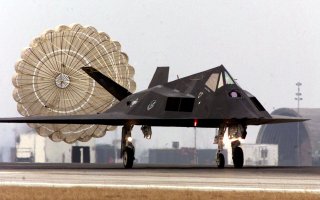F-117: The Stealth Fighter That Made the U.S. Military 'Invisible'
The fighter was so secret that it was in service for six years before the U.S. Air Force even admitted its existence.
The exact potential of an advanced weapon system is never really known until it is tested in combat. This was certainly true of the stealth aircraft the United States developed during the Cold War—it was also the sort of weapon that most military planners would never want to see a need to be used.
Then with the dissolution of the Warsaw Pact, it might have seemed that aircraft such as the F-117 wouldn’t ever be used in actual combat. Lockheed Martin had delivered 59 of the stealth fighters to the United States Air Force between 1982 and July 1990. Developed at Lockheed’s so-called “Skunk Works” in Burbank, California it was designed to be virtually invisible to radar, and difficult to spot with the naked eye. The fighter was so secret that it was in service for six years before the U.S. Air Force even admitted its existence.
It was developed to address Soviet threats, but as the Cold War wound down it might have seemed as if the billions spent had been for nothing. The F-117 was finally used in action in December 1989 during Operation Just Cause in Panama, when a pair of fighters targeted outside the Panamanian Defense Forces barracks.
It was overkill, and really didn’t prove whether the aircraft could take on a more prepared enemy. It would be over a year however before the F-117 truly had a chance to show its potential in delivering utter devastation to the enemy when it was used against Iraqi positions in the early stages of the Gulf War. From the first night of the attacks, the F-117A was employed against critical strategic Iraqi command and control installations as well as key communication centers, research & development, production and storage facilities for nuclear and chemical weapons. It also was used to target especially hardened aircraft shelters at numerous Iraqi airfields.
Standard F-117 mission preparation could take six hours, and the flight time from al Udeid Air Base in Qatar to Baghdad was another two hours. Unlike the mission over Panama, the F-117 had to fly deep inside a super-missile engagement zone that also had an anti-aircraft artillery trap that was prepared for an airborne attack. The small “Black Jets” had to sneak past Iraq’s border radar defenses and it was timed so that they’d be right over Baghdad when the air war kicked off at 3am.The aircraft carried 2,000 pound GBU-27 laser guided bombs that hit the targets, essentially cutting out the Iraqi military’s eyes in the process. With its stealth capabilities it was more than up to the job, and was the only coalition jet able to strike the targets inside Baghdad’s city limits.
What is especially remarkable about the F-117 was that only 36 of the stealth fighters were deployed in Desert Storm—accounting for just 2.5% of the total force of 1,900 fighters and bombers, but these flew more than a third of the bombing runs on the first day of the war. In total during the operation the F-117 conducted more than 1,250 sorties and dropped more than 2,000 tons of bombs during the missions that lasted a combined 6,900 hours!
The other remarkable part of the story is that Iraqi defenses consisted of some 3,000 anti-aircraft guns with 60 surface-to-air missile batteries protecting the capital and yet the F-117 operated from the skies above with impunity. Not a single F-117 was shot down during the conflict.
Peter Suciu is a Michigan-based writer who has contributed to more than four dozen magazines, newspapers and websites. He is the author of several books on military headgear including A Gallery of Military Headdress, which is available on Amazon.com.

